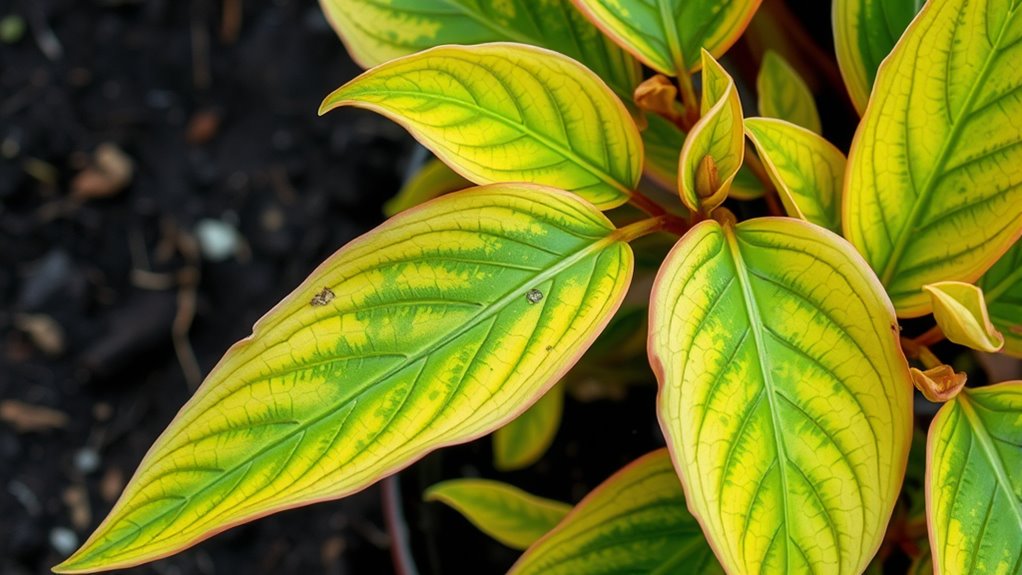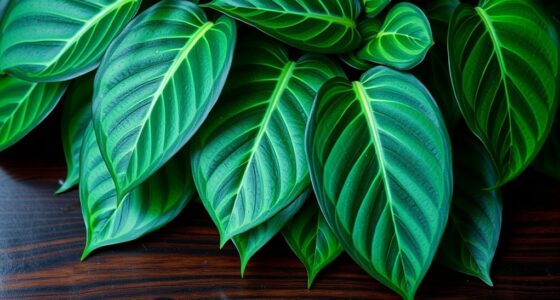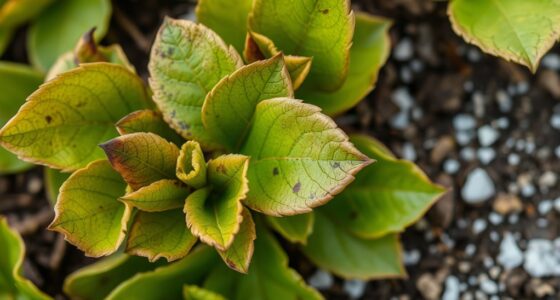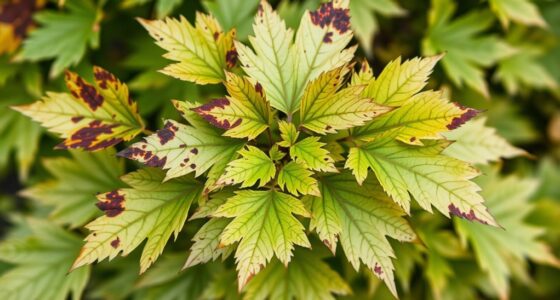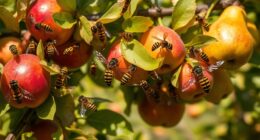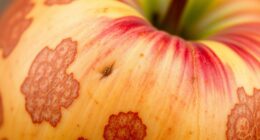If your photinia’s leaves turn yellow, think about whether it’s iron deficiency or root rot causing the problem. Iron deficiency typically causes uniform yellowing between the veins, usually starting with new leaves, and plants may look otherwise healthy. Root rot, however, leads to uneven yellow patches, wilting, and sometimes blackened roots. Check the overall growth and soil conditions. To identify the true cause and find the right fix, keep exploring the signs and solutions detailed below.
Key Takeaways
- Uniform yellowing, especially on new leaves with green veins, suggests iron chlorosis; irregular patches and browning indicate root rot.
- Sudden yellowing after rain and blackened, soggy roots point to root rot; gradual, consistent yellowing on new growth suggests iron deficiency.
- Check for root decay signs like foul smell and slimy roots to confirm root rot; healthy roots are firm and white.
- Iron deficiency causes pale, uniform yellowing between veins, while root rot results in patchy yellowing and overall plant decline.
- Proper soil pH, drainage, and root inspection help distinguish between nutrient deficiency and root rot causes.
Recognizing the Symptoms of Yellowing Leaves

Yellowing leaves on your photinia are often the first sign something’s off with the plant’s health. You’ll notice leaf discoloration starting at the edges or spreading across the foliage, signaling a problem. As symptoms progress, the yellowing may become more widespread, affecting new and old leaves alike. Look closely—yellowing that begins between the veins and spreads outward can indicate nutrient issues or root problems. You might also see leaves curling, dropping prematurely, or developing spots. Recognizing these early signs helps you catch trouble early. Keep in mind, the symptom progression varies; sometimes, yellowing is the first step before more severe symptoms appear. Being attentive to these changes allows you to take timely action and prevent further damage. Monitoring plant health metrics, such as soil conditions and root vitality, can aid in diagnosing the underlying issue. Additionally, understanding plant disease symptoms can help distinguish between iron deficiency and root rot. Addressing soil nutrient levels promptly can often reverse early signs of deficiency before root damage becomes severe.
Understanding Iron Deficiency and Its Effects
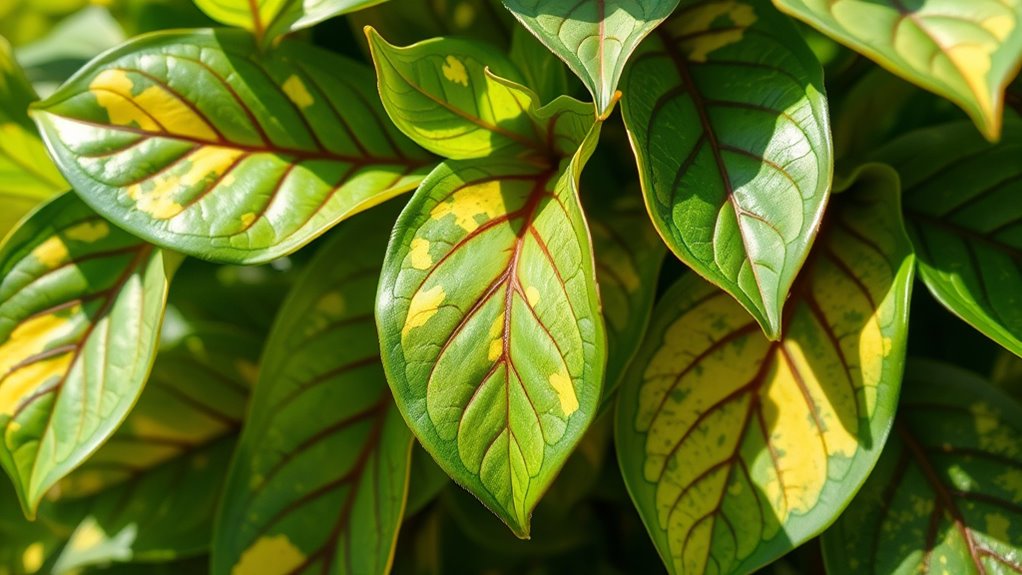
Iron is essential for your plant’s healthy growth, helping produce chlorophyll and keep leaves green. When your Photinia shows yellowing leaves, it could be a sign of iron deficiency, which hampers nutrient transport. To prevent this, you need to recognize the symptoms early and take steps to guarantee your plant gets enough iron. Maintaining proper soil conditions can significantly influence iron availability and overall plant health. Additionally, understanding how AI in media and entertainment impacts content creation can help in developing innovative gardening tools and educational resources. Recognizing the role of soil pH levels is crucial, as they directly affect iron solubility and uptake by plants.
Iron’s Role in Plants
Have you ever noticed your plants developing pale or yellowish leaves despite adequate watering and sunlight? Iron is vital for forming chlorophyll, which gives leaves their green color. Without enough iron, your plants can’t produce enough chlorophyll, leading to yellowing leaves. To fix this, you can use foliar feeding, spraying iron solutions directly onto the leaves for quick absorption. Improving soil health with amendments like compost or iron chelates also boosts iron availability. Here are three key points:
- Iron is essential for chlorophyll synthesis.
- Iron deficiency causes yellowing leaves, not necessarily related to watering.
- Combining foliar feeding with soil amendments ensures better iron uptake.
- Using soil testing techniques can help remove excess salts and improve soil conditions, enhancing iron absorption.
Understanding iron’s role helps you address deficiencies effectively and keep your plants healthy.
Signs of Iron Deficiency
When plants struggle to absorb enough nutrients, they often show telltale signs of deficiencies, and iron deficiency is no exception. One common sign is yellowing leaves, especially between the veins, while the veins remain green. This condition, known as chlorosis, often appears on new growth first. Pest infestations can worsen iron deficiency by weakening the plant’s defenses, making it more vulnerable. Additionally, improper pruning techniques can stress the plant, impairing nutrient uptake and exacerbating chlorosis. If you notice yellowing leaves that don’t improve with watering or fertilizing, inspect for pests and adjust your pruning approach. Addressing pest issues and avoiding unnecessary pruning can help restore iron absorption, preventing further yellowing and supporting healthy growth. Regularly assessing and properly managing soil conditions can also help prevent issues like root rot and nutrient deficiencies.
Preventing Nutrient Deficit
Ever wondered how to keep your plants healthy and prevent nutrient deficiencies like iron deficiency? To avoid issues like yellowing leaves, focus on proactive strategies. First, consider foliar feeding—applying nutrients directly to leaves helps quickly correct deficiencies. Second, use proper pruning techniques to improve airflow and root health, reducing stress that can lead to nutrient problems. Third, make certain your soil has balanced pH levels and adequate organic matter to enhance nutrient availability. Regularly monitor your plant’s health, adjusting feeding schedules as needed. Additionally, choosing the right fertilizer application method can optimize nutrient uptake and prevent deficiencies. Ensuring proper soil testing helps identify specific nutrient imbalances before they affect plant health. Being aware of nutrient deficiencies can help you act early to prevent visible issues. By combining foliar feeding with thoughtful pruning, you can prevent nutrient deficits before they become visible issues. This proactive approach keeps your Photinia lush, vibrant, and resistant to iron chlorosis.
Identifying Signs of Root Damage or Rot
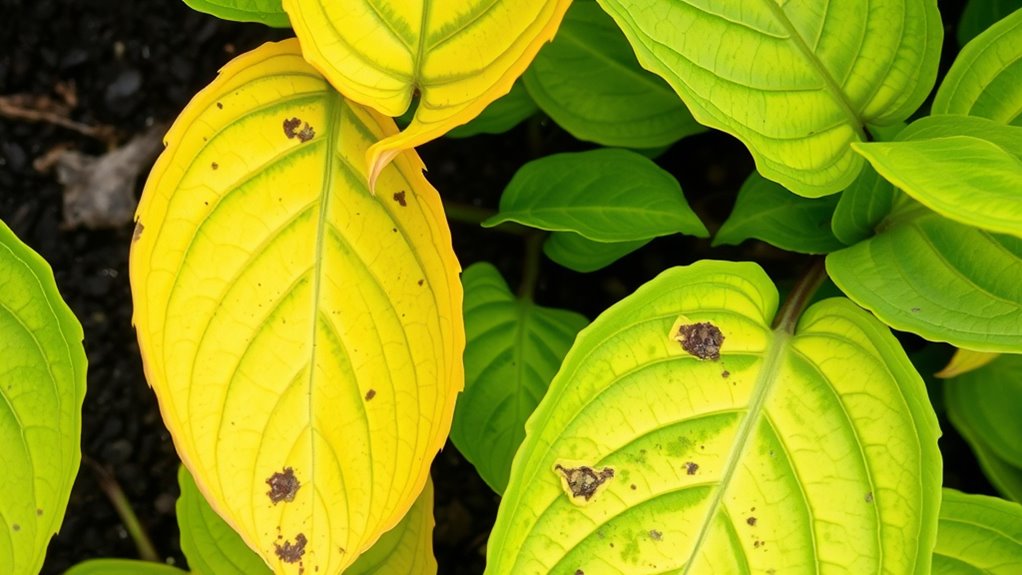
You can often spot root damage or rot in photinia plants by examining the base of the plant and the surrounding soil. Look for signs like a foul odor, soggy or discolored roots, or a wilting plant despite proper watering. Healthy roots are firm and white, while rotted ones are brown or black and slimy. To prevent further damage, use proper pruning techniques to remove any visibly affected roots carefully. Good pest management is essential, as pests like root maggots can weaken roots and promote rot. Avoid overwatering, which creates a damp environment conducive to root rot. Regularly inspect your plant’s base and soil, acting promptly if you notice any signs of damage to protect your photinia’s health. Understanding the factors influencing root health can help you implement better care practices and prevent issues like root rot. Additionally, maintaining proper soil drainage is vital to reduce the risk of persistent moisture that encourages rot.
Comparing Leaf Color Changes in Iron Deficiency vs. Root Rot
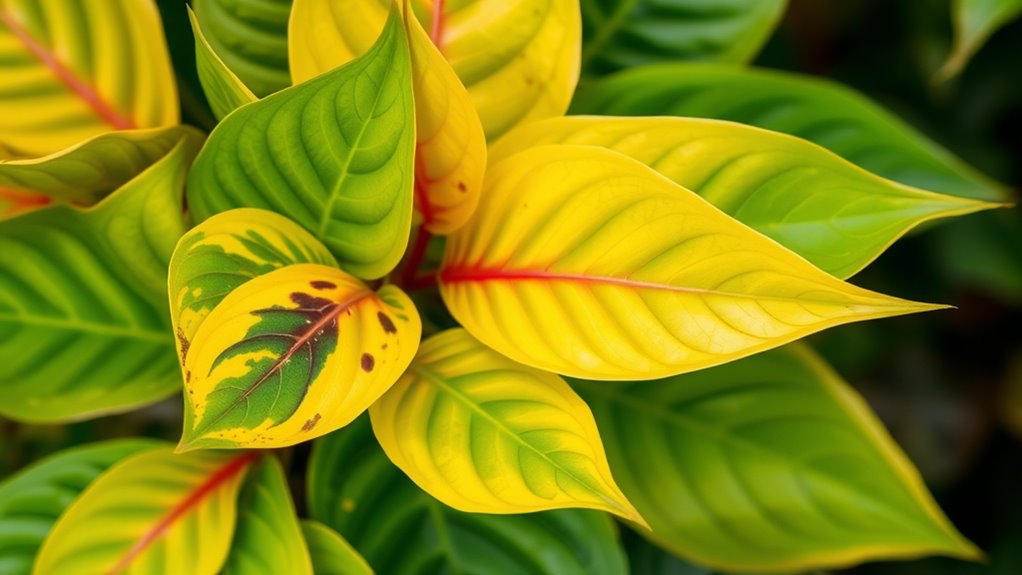
You’ll notice that iron deficiency often causes uniform yellowing starting in the youngest leaves, while root rot may lead to uneven or yellowing leaves with browning edges. The timing of symptoms can also differ, with iron issues appearing gradually, and root rot causing rapid decline. Pay attention to other plant signs, like wilting or root decay, to tell these conditions apart. Additionally, inspecting the plant’s roots can reveal whether decay is present, helping to accurately diagnose the underlying problem. Recognizing plant health indicators can further assist in diagnosing whether nutrient deficiency or root damage is the culprit. Being aware of diagnostic signs can help differentiate between these common issues more effectively.
Leaf Color Patterns
While both iron deficiency and root rot can cause yellowing in photinia leaves, their color patterns often differ, helping you identify the underlying issue. Iron deficiency typically results in uniform, pale yellow leaves with consistent color variation across the leaf surface. The leaf pattern may show yellowing starting at the new growth or along the veins. Conversely, root rot usually causes irregular yellow patches or spots, often accompanied by brown, decayed areas. The color variation in root rot-affected leaves can be uneven, with some parts remaining green. Recognizing these differences is key. Additionally, understanding leaf color patterns can aid in early diagnosis and effective treatment.
Timing of Symptoms
Understanding when yellowing occurs can help distinguish between iron deficiency and root rot in photinia. The timing of symptoms is essential; leaf discoloration from iron deficiency often appears gradually, starting with new growth turning yellow first. This slow progression indicates a deficiency in nutrient uptake rather than root damage. In contrast, with root rot, yellowing can happen suddenly or progressively, often starting on older leaves as the roots deteriorate and can’t absorb nutrients effectively. You might notice rapid leaf discoloration or wilting, especially during or after rainy periods. Recognizing these timing patterns helps you identify the cause early. Consistent, slow leaf yellowing suggests iron deficiency, while abrupt or widespread yellowing indicates root rot, prompting different treatment approaches.
Additional Plant Signs
When comparing leaf color changes caused by iron deficiency and root rot, distinct signs can help you distinguish between them. Leaf discoloration from iron deficiency often appears as uniform yellowing, especially on new leaves, indicating a nutrient imbalance. In contrast, root rot may cause uneven leaf yellowing, wilting, or browning, often accompanied by other plant stress signs. To identify the issue, look for these additional signs:
- Wilting or soft, mushy roots indicating root rot
- Yellowing starting on older leaves (iron deficiency) versus newer leaves (root rot)
- Overall plant decline with stunted growth or blackened roots
Recognizing these signs helps determine whether leaf discoloration stems from a nutrient imbalance or root health problem.
Examining the Plant’s Overall Health and Growth Patterns
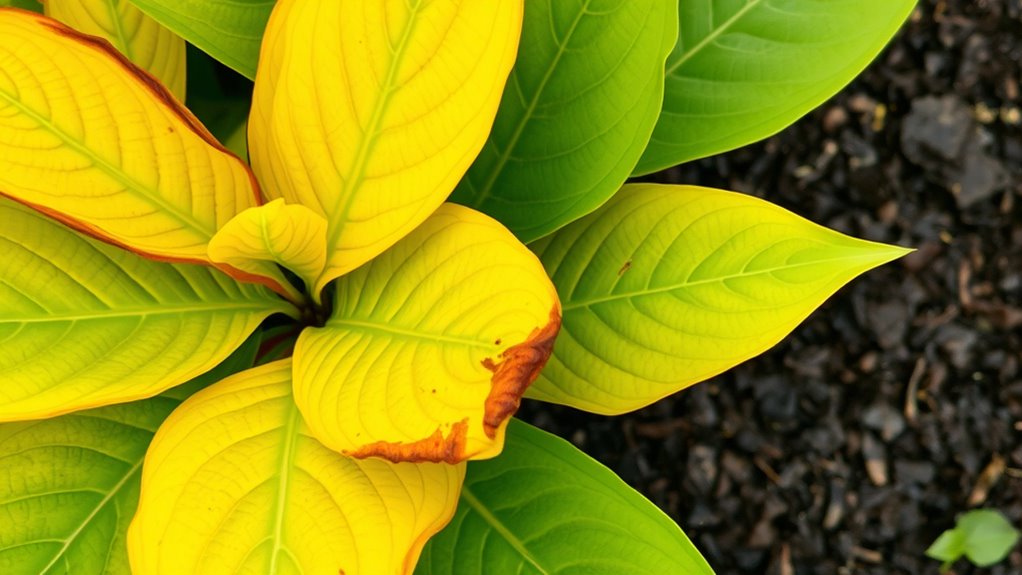
To assess your photinia’s overall health and growth patterns, start by observing its foliage and stems closely. Look for signs of uniform growth or uneven development, which can indicate underlying issues. Check if new leaves are healthy and if older leaves are yellowing, suggesting possible nutrient problems. Pruning techniques are essential to maintain good airflow and remove dead or diseased branches, reducing stress on the plant. Also, inspect for pests that can weaken the plant and cause irregular growth. Consistent growth patterns and healthy foliage typically point to a well-maintained plant, while irregularities may signal deeper problems like root issues or nutrient deficiencies. Regular monitoring helps you catch issues early, enabling effective pest management and pruning to support overall essentiality.
Soil Conditions That Contribute to Iron Deficiency
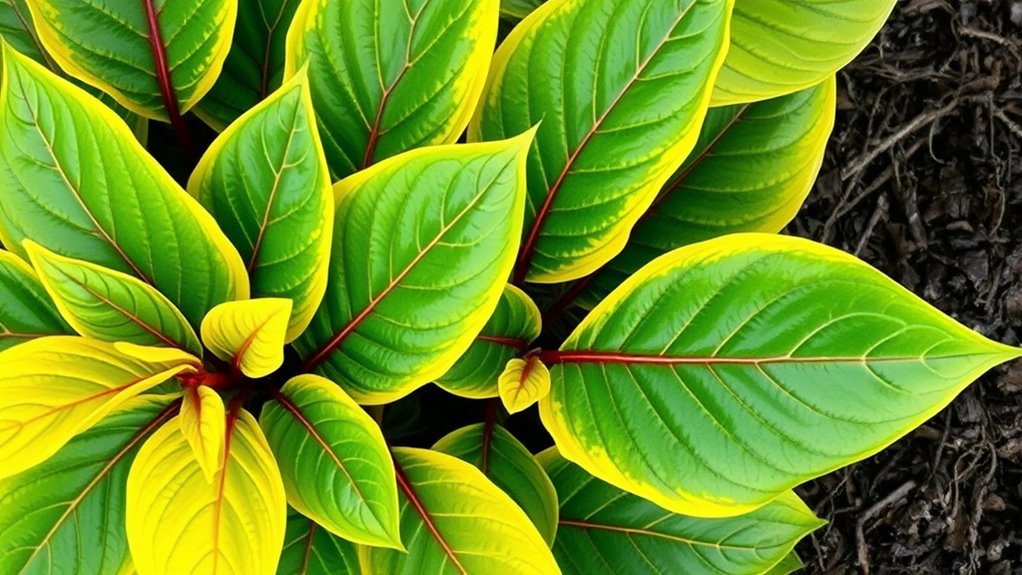
Your soil’s pH level can make a big difference in how well your Photinia absorbs iron. If the soil is too alkaline or acidic, it can lead to iron deficiency and yellowing leaves. Additionally, poor drainage can cause roots to become waterlogged, preventing proper nutrient uptake.
Soil Ph Imbalance
Soil pH imbalance is a common factor that can lead to iron deficiency in Photinia plants. When the soil becomes too alkaline, iron becomes less available, causing yellowing leaves. To prevent this, you should monitor your soil nutrient levels and contemplate pH adjustment methods.
Here are key points to consider:
- High soil pH reduces iron solubility, leading to deficiency symptoms.
- Regular soil testing helps identify pH imbalances early.
- Adjust soil pH with amendments like sulfur or organic acids to improve iron availability.
Poor Drainage Conditions
Poor drainage can cause water to accumulate around Photinia roots, creating oxygen-deprived conditions that hinder nutrient uptake, including iron. When soil stays too wet, roots can’t access essential oxygen, leading to deficiencies that cause yellowing leaves. Improving soil aeration helps prevent waterlogging and promotes healthy root function. Incorporate organic amendments like compost to enhance drainage and soil structure, guaranteeing excess water drains efficiently. Consider these options:
| Drainage Solution | Benefits |
|---|---|
| Adding organic matter | Improves soil aeration and structure |
| Installing drainage systems | Prevents water buildup around roots |
| Creating raised beds | Elevates roots for better drainage |
Addressing poor drainage ensures your Photinia receives adequate oxygen, reducing the risk of iron deficiency.
Signs of Fungal Infection in the Roots
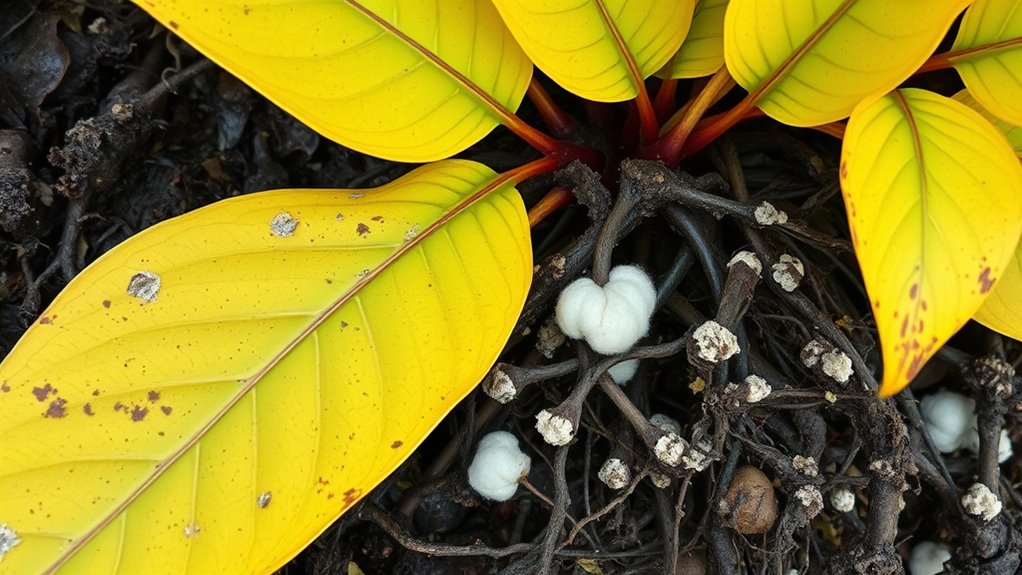
Fungal infections in the roots often present subtle yet telltale signs that can be detected early. You might notice stunted growth, wilting, or yellowing leaves despite adequate watering. Root decay may cause the roots to appear brown, slimy, or mushy when you inspect the soil or root zone. These symptoms indicate fungal root infections, which hinder nutrient uptake and weaken the plant. To manage soil pathogens effectively, early detection is key.
Here are some signs to look for:
- Discolored, rotting roots with a foul smell
- Reduced root mass or root dieback
- Overall decline in plant vigor and health
Monitoring these signs helps you implement proper soil pathogen management to prevent further damage.
Diagnostic Tests and Soil Analysis Methods
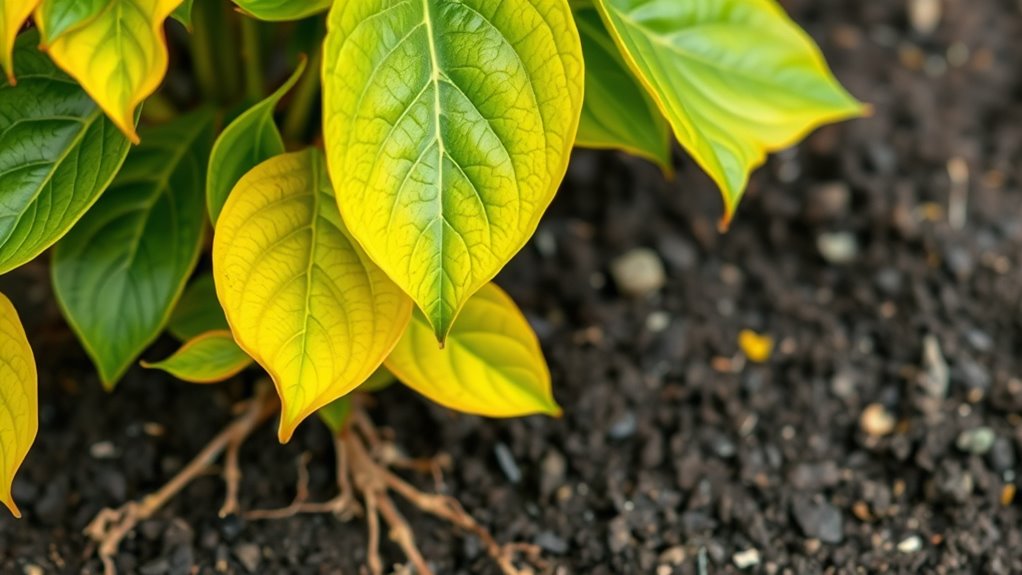
Early detection of root infections relies on effective diagnostic tests and soil analysis methods. You should start by collecting soil samples around your Photinia’s root zone and sending them to a lab for nutrients and pH testing. This helps identify deficiencies like iron, which can cause yellowing leaves. Use soil amendment strategies, such as adding iron-rich materials, if deficiencies are detected. Additionally, foliar spray applications can help temporarily improve iron availability and assess plant response. Visual inspections for root rot symptoms, combined with soil tests, give a clearer picture of underlying issues. Regular monitoring and soil analysis allow you to differentiate between iron chlorosis and root rot, guiding proper treatment decisions and preventing further damage to your plant.
Effective Treatment Options for Iron Chlorosis
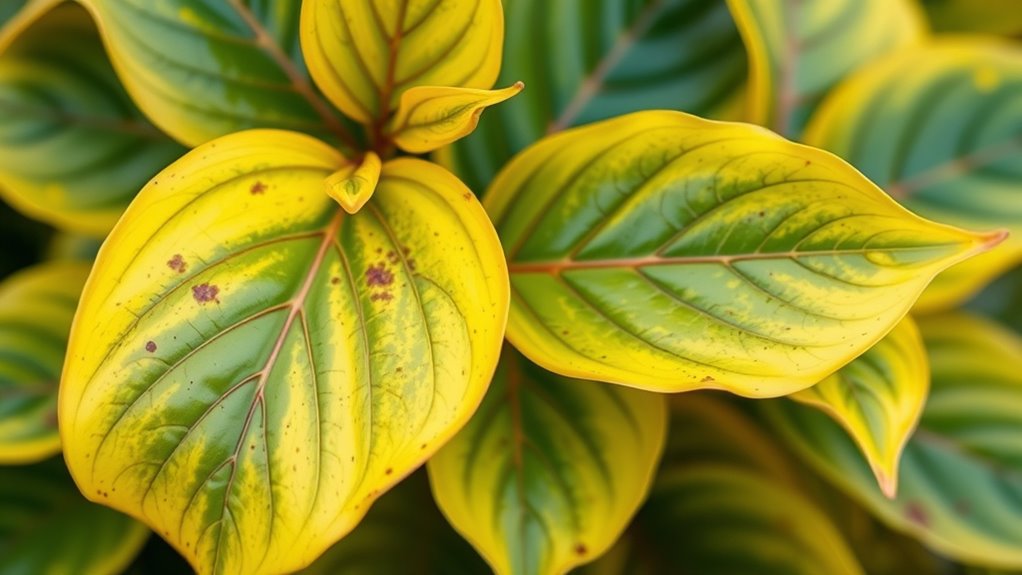
To effectively treat iron chlorosis in your Photinia, you should focus on correcting iron deficiencies through targeted amendments and applications. First, apply chelated iron or iron sulfate fertilizers to improve iron availability in the soil. Second, use proper pruning techniques to remove dead or yellowed leaves, which helps enhance nutrient uptake and airflow. Third, enhance soil conditions by adjusting pH levels; lowering soil pH can increase iron solubility. Regular fertilizer application ensures consistent iron supply, while pruning promotes healthier growth. Combining these strategies addresses iron deficiency directly and encourages vigorous, green foliage. Remember, timely intervention is key—monitor your plant’s response and adjust treatments as necessary for ideal results.
Approaches to Managing Root Rot and Preventing Recurrence

While treating iron deficiencies helps keep your Photinia healthy, preventing root rot requires proactive management of soil and watering practices. Start by improving soil drainage with amendments like compost or coarse sand to prevent excess moisture around roots. Avoid overwatering; water only when the soil feels dry several inches below the surface. Incorporate soil amendments that promote aeration and prevent waterlogging. Use fertilizer strategies that focus on balanced, well-draining nutrients to strengthen root health without encouraging fungal growth. Regularly inspect your plant for signs of stress or decay, and remove any affected roots promptly. Applying a fungicide labeled for root rot can help if infection occurs. Consistent management of soil conditions and watering habits considerably reduces root rot recurrence and keeps your Photinia thriving.
Frequently Asked Questions
Can Environmental Stress Cause Yellowing Leaves in Photinia?
Yes, environmental stress can cause yellowing leaves in your photinia. Factors like drought, poor soil drainage, or extreme temperatures stress the plant, leading to yellowing. To help, you should consider soil amendments to improve soil health and moisture retention. Also, practice pest management to reduce additional stress from pests, which can exacerbate leaf yellowing. Addressing these environmental factors promotes healthier, greener foliage.
How Often Should I Test Soil Ph for Iron Deficiency?
You should test your soil pH at least once a year to guarantee proper pH management. Regular soil testing helps you catch iron deficiency early and adjust soil conditions accordingly. If you notice yellowing leaves or other signs of nutrient issues, consider testing more frequently, especially during active growing seasons. Maintaining ideal pH levels supports healthy plant growth and prevents problems like iron chlorosis.
Are There Specific Watering Practices to Prevent Root Rot?
You might notice that proper watering practices prevent root rot from happening. To do this, adjust your watering frequency, ensuring you don’t overwater or underwater your plants. Improving drainage around the roots also helps, especially if your soil tends to stay soggy. By monitoring watering habits and enhancing drainage, you create a healthier environment that reduces the risk of root rot, keeping your plants vibrant and strong.
What Are Natural Remedies for Iron Chlorosis?
If you’re dealing with iron chlorosis, natural remedies can help, like applying compost tea or organic sprays rich in iron. You should regularly mist the leaves with compost tea to boost iron absorption and improve overall health. Additionally, use organic chelators or sprays designed to increase iron availability in the soil. These eco-friendly solutions support your plant’s recovery without harmful chemicals, promoting vibrant, green foliage naturally.
How Long Does It Take to See Improvement After Treatment?
Think of your plant’s recovery as a sunrise—slow but hopeful. After applying soil amendments and pH adjustment, you’ll usually see signs of improvement within 2 to 4 weeks. Keep nurturing your plant, and be patient as it regains its vibrant health. Consistent care and proper soil adjustments help restore iron uptake, turning yellow leaves back to lush green in time, like a new dawn for your photinia.
Conclusion
Don’t ignore yellowing leaves—they could signal iron deficiency or root rot, but early detection makes all the difference. You might worry treatment won’t work or that it’s too complicated, but with proper diagnosis and care, you can restore your photinia’s health. Addressing the problem promptly prevents further damage and saves your plant. So, take action now—your photinia’s vibrant green color is worth the effort!
